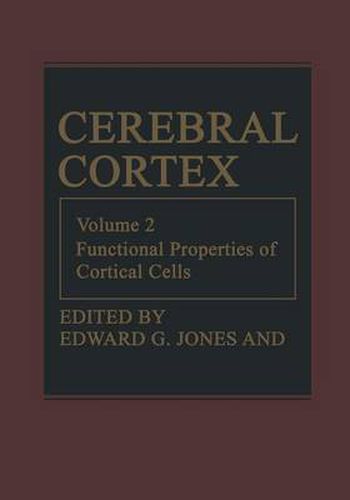Readings Newsletter
Become a Readings Member to make your shopping experience even easier.
Sign in or sign up for free!
You’re not far away from qualifying for FREE standard shipping within Australia
You’ve qualified for FREE standard shipping within Australia
The cart is loading…






This title is printed to order. This book may have been self-published. If so, we cannot guarantee the quality of the content. In the main most books will have gone through the editing process however some may not. We therefore suggest that you be aware of this before ordering this book. If in doubt check either the author or publisher’s details as we are unable to accept any returns unless they are faulty. Please contact us if you have any questions.
Volume 2 of Cerebral Cortex continues our policy of dealing with the individual elements of the cerebral cortex before moving on in subsequent volumes to a consideration of the details of the various functional areas. Volume 1 of the treatise dealt with the morphology of cortical neurons, and Volume 2 continues this theme to some extent by including chapters devoted to the morphology of cortical neuroglial cells, of immunocytochemically labeled neurons, and of in tracellularly i~ected neurons. However, the major emphasis of this volume and of Volume 3, which will follow it, is on the functional characteristics of cortical neurons and neuroglial cells, particularly those of transmitter and receptor iden tity and of electrophysiological uniqueness. Volume 2 emphasizes these char acteristics in relation to the intrinsic cortical elements; Volume 3 will continue this and add chapters on the afferent and efferent systems of the cortex. Together, Volumes 2 and 3 will cover all of the transmitters, receptors, and related compounds that have so far been discovered in the cerebral cortex. It is the interrelations among the neuronal elements expressing these materials that determine the functional operations of the cerebral cortex, and the necessity for understanding how the appropriate cooperation between the neuronal ele ments is achieved is highlighted by Sir John C. Eccles’s introductory chapter on The Cerebral Neocortex: A Theory of Its Operation.
$9.00 standard shipping within Australia
FREE standard shipping within Australia for orders over $100.00
Express & International shipping calculated at checkout
This title is printed to order. This book may have been self-published. If so, we cannot guarantee the quality of the content. In the main most books will have gone through the editing process however some may not. We therefore suggest that you be aware of this before ordering this book. If in doubt check either the author or publisher’s details as we are unable to accept any returns unless they are faulty. Please contact us if you have any questions.
Volume 2 of Cerebral Cortex continues our policy of dealing with the individual elements of the cerebral cortex before moving on in subsequent volumes to a consideration of the details of the various functional areas. Volume 1 of the treatise dealt with the morphology of cortical neurons, and Volume 2 continues this theme to some extent by including chapters devoted to the morphology of cortical neuroglial cells, of immunocytochemically labeled neurons, and of in tracellularly i~ected neurons. However, the major emphasis of this volume and of Volume 3, which will follow it, is on the functional characteristics of cortical neurons and neuroglial cells, particularly those of transmitter and receptor iden tity and of electrophysiological uniqueness. Volume 2 emphasizes these char acteristics in relation to the intrinsic cortical elements; Volume 3 will continue this and add chapters on the afferent and efferent systems of the cortex. Together, Volumes 2 and 3 will cover all of the transmitters, receptors, and related compounds that have so far been discovered in the cerebral cortex. It is the interrelations among the neuronal elements expressing these materials that determine the functional operations of the cerebral cortex, and the necessity for understanding how the appropriate cooperation between the neuronal ele ments is achieved is highlighted by Sir John C. Eccles’s introductory chapter on The Cerebral Neocortex: A Theory of Its Operation.